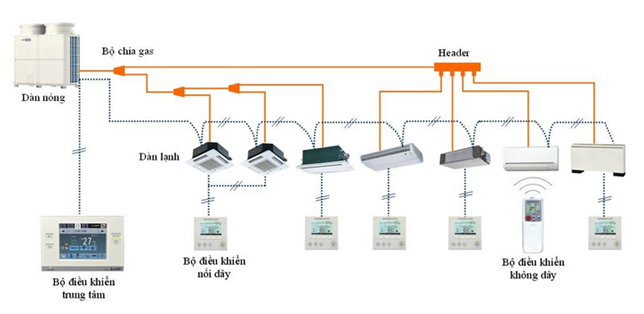Nowadays, the demand for cooling/heating is increasing day by day. And industrial parks, factories, hospitals, schools, hotels are even more necessary. To cool such large spaces, using local air conditioners is not effective. What is the solution here? VRV central air conditioner is the perfect choice for your project. So what is VRV central air conditioner? Structure, advantages and disadvantages of the system? Let ‘s find out the article below with P69 company
What is VRV central air conditioner?
Central air conditioning system is a system consisting of one or more central machines that combine into an overall cold distribution system for all areas in the building. The central air conditioning system uses water as the cooling agent through the water pipeline system to the heat exchangers to cool the air.
VRV stands for the English word “Variable Refrigerant Volume”. VRV central air conditioning system is a type of air conditioning system for high-rise buildings, large-area works and with limited placement of separate cooling outdoor units. Daikin is the first air conditioner manufacturer to have invented the central air conditioning system and it has been more than 20 years so far. In the VRV air conditioning system, the central air conditioner VRV III is a greatly improved version, which is considered as a revolution in the development process of the VRV air conditioning system up to the present time.
Structure of central air conditioner VRV
What is vrv central air conditioner has been answered above, now let’s find out the structure of VRV.
Types of VRV refrigeration systems have the same basic structure, including: outdoor unit, indoor unit system, pipeline system and gas splitter. Details of each part are as follows:

1. VRV . outdoor unit
- This is the most important part in the VRV air conditioning system.
- The outdoor unit includes: throttle valve, compressor, outdoor fan, heat exchanger pipe system and many other auxiliary equipment.
- The outdoor unit of a VRV refrigeration system may consist of one or more outdoor units.
- The refrigerant compressor of the outdoor unit is usually a centrifugal type with a flexible ducted spiral.
2. Indoor unit
- VRV central air conditioning system usually has many indoor units (usually the indoor unit system will have from 6 to 14 indoor units).
- Many indoor units will be connected to the outdoor unit, the number of indoor units connected to one outdoor unit is not limited, just the total capacity of the indoor units fluctuates between 50 and 130% of the capacity of the hot unit.
- The design and capacity of the units in the same system do not have to be the same.
- Although the indoor units are installed with one outdoor unit, turning off one unit does not affect the operation of other units.
- The user can control the indoor units by grouping controls of the ventilation openings.
3. Conduit system
- This is a system of copper conduits connected by specialized fittings (REFNET).
- This system is responsible for distributing gas from the outdoor unit to the indoor units in the system.
4. Gas splitter
- As the name suggests, this unit is responsible for distributing gas to the indoor units in the system.
- This gas splitter is divided into two pipes equivalent to two directions for gas division.
Classification of central air conditioners VRV
VRV central air conditioning system has 4 main types as follows:
+ VRV central air conditioning system on the floor
+ VRV central air conditioning system wall mounted
+ Central air conditioning system VRV casstle ceiling
+ VRV central air conditioning system with ceiling duct connection
Depending on the needs of use, people choose the most suitable VRV system.
Outstanding advantages and disadvantages of VRV . central air conditioners
Just like other air conditioning systems, VRV air conditioning systems also have many advantages and disadvantages. As follows:

1. Outstanding advantages of VRV . central air conditioner
Central air conditioning system has great advantages such as:
- Good energy saving
- Small operating costs
- Simple installation, short time. Can operate when some indoor units are damaged or under repair
- Small piping system suitable for small installation spaces
- Wide temperature range
2. Outstanding disadvantages of central air conditioner VRV
The biggest disadvantage of the VRV central air conditioning system is that it is not suitable for buildings with many small rooms with different operating and usage modes, or in other words, there is no synchronization.
Therefore, when choosing an air conditioning system, you should evaluate the suitability and carefully consider whether to choose the best. VRV air conditioning system for very large wind volume is especially suitable for crowded areas such as restaurants, large halls; restaurants, cinemas…
Working principle of central air conditioner vrv
The working principle of VRV central air conditioning system is as follows:
- Gas (solvent) will be cooled at the outdoor unit. The process of cooling gas at the outdoor unit is as follows: Gas is pumped into the compressor, where the gas will be compressed with high pressure temperature => Gas passes through the throttle valve to be cooled down to become cold gas.
- Gas, after being cooled at the outdoor unit, will be led into the divider and copper pipe system. Here the splitter will divide the refrigerant gas to the indoor units of the system.
- As refrigerant moves through the coil system, the copper tube causes the surrounding air to lose its temperature. At this time, the blower will work to blow the cold air to the outside (to the space that needs to be conditioned).
Contact us today for a free consultation and answer at:
Contact information P69 – M&E Contractor
Address: No. 6/165C Xuan Thuy, Cau Giay District, Hanoi
Website: https://p69.com.vn/
Hotline: 02422121212 – 0965937799
Email: kd@cokhip69.com.vn
Facebook: https://www.facebook.com/p69nhathaucodien
LinkedIn: https://www.linkedin.com/in/congtyp69/
Youtube : https://www.youtube.com/channel/UCOUwCnE5iGj8iqe_ZIUM7oA

